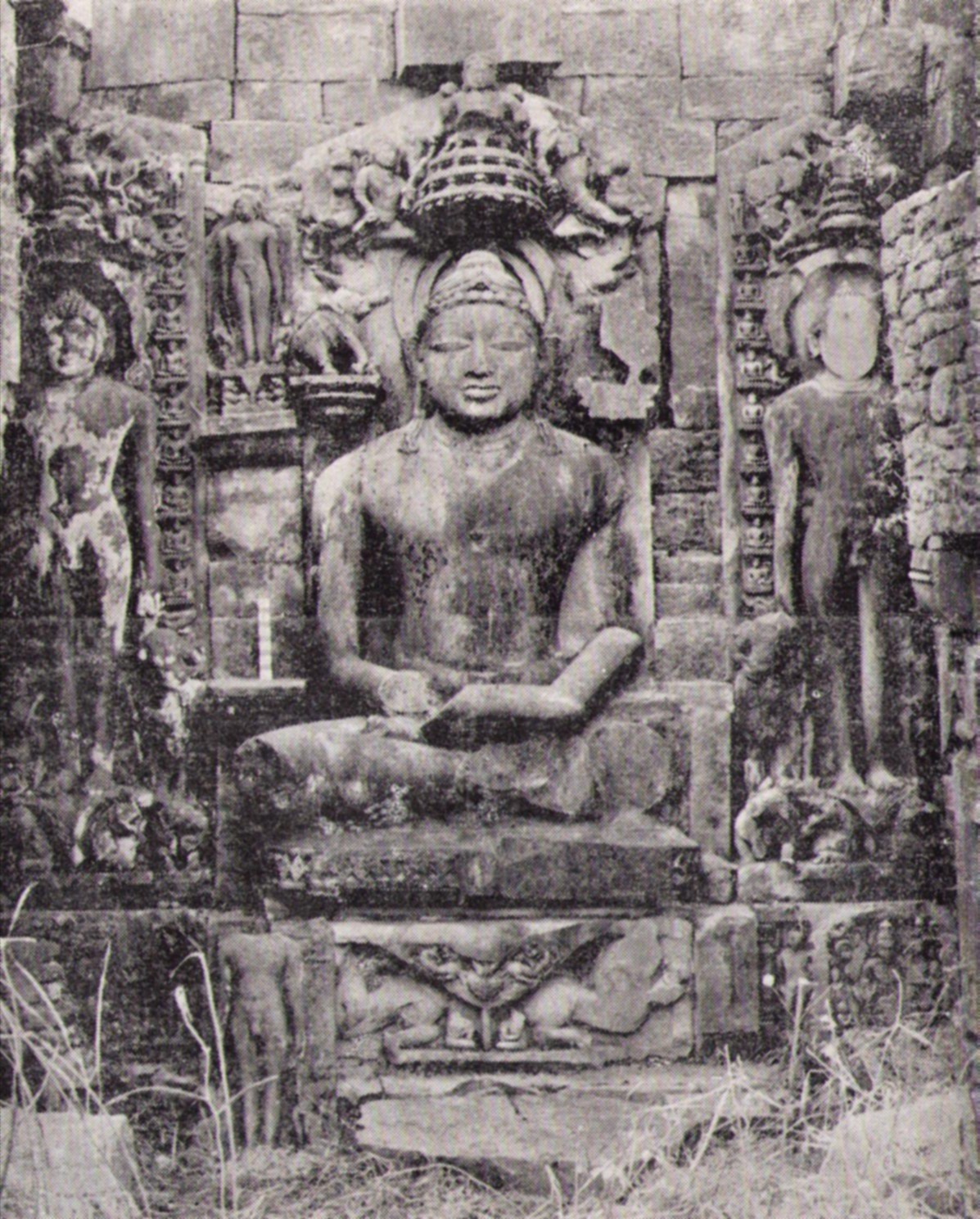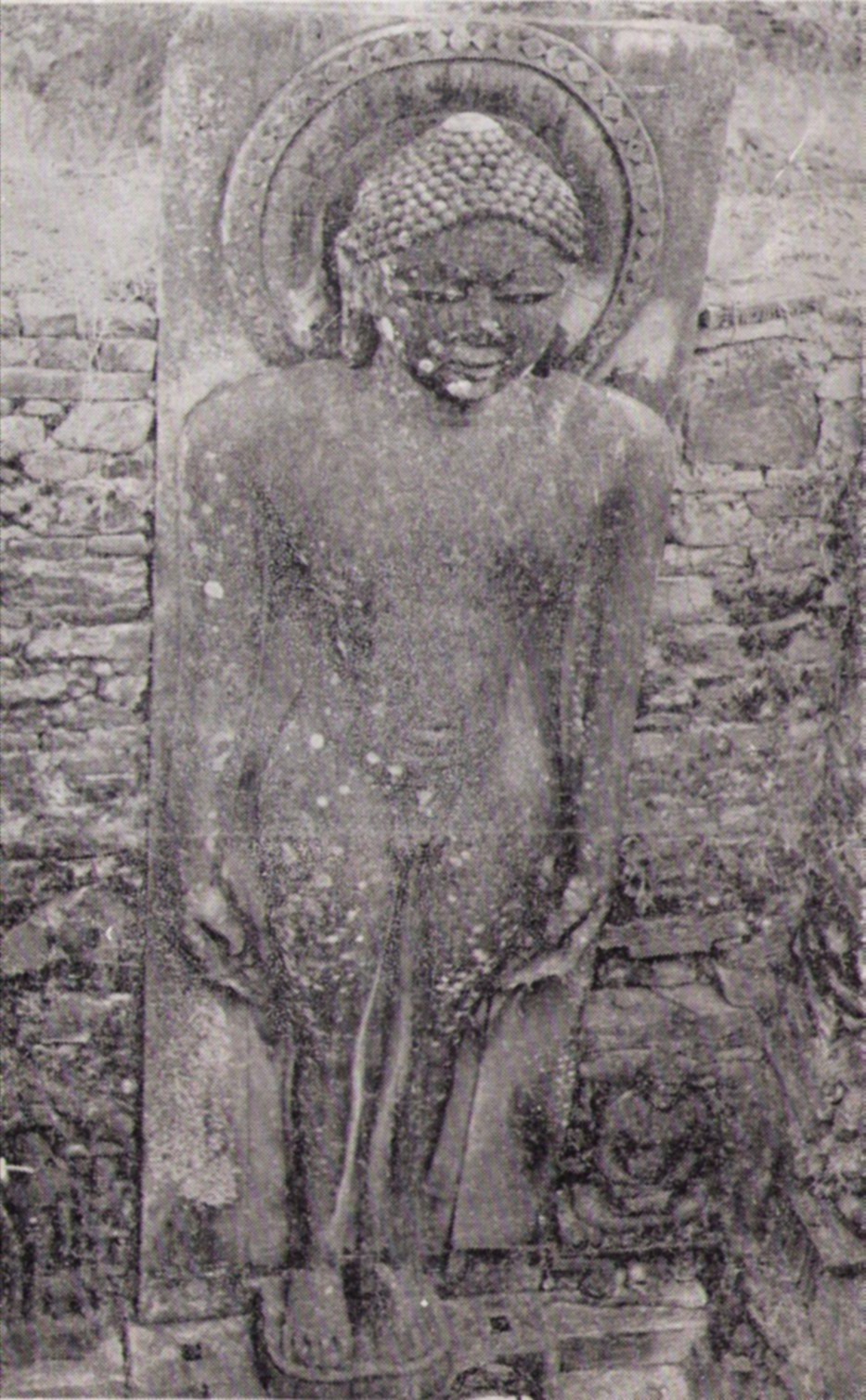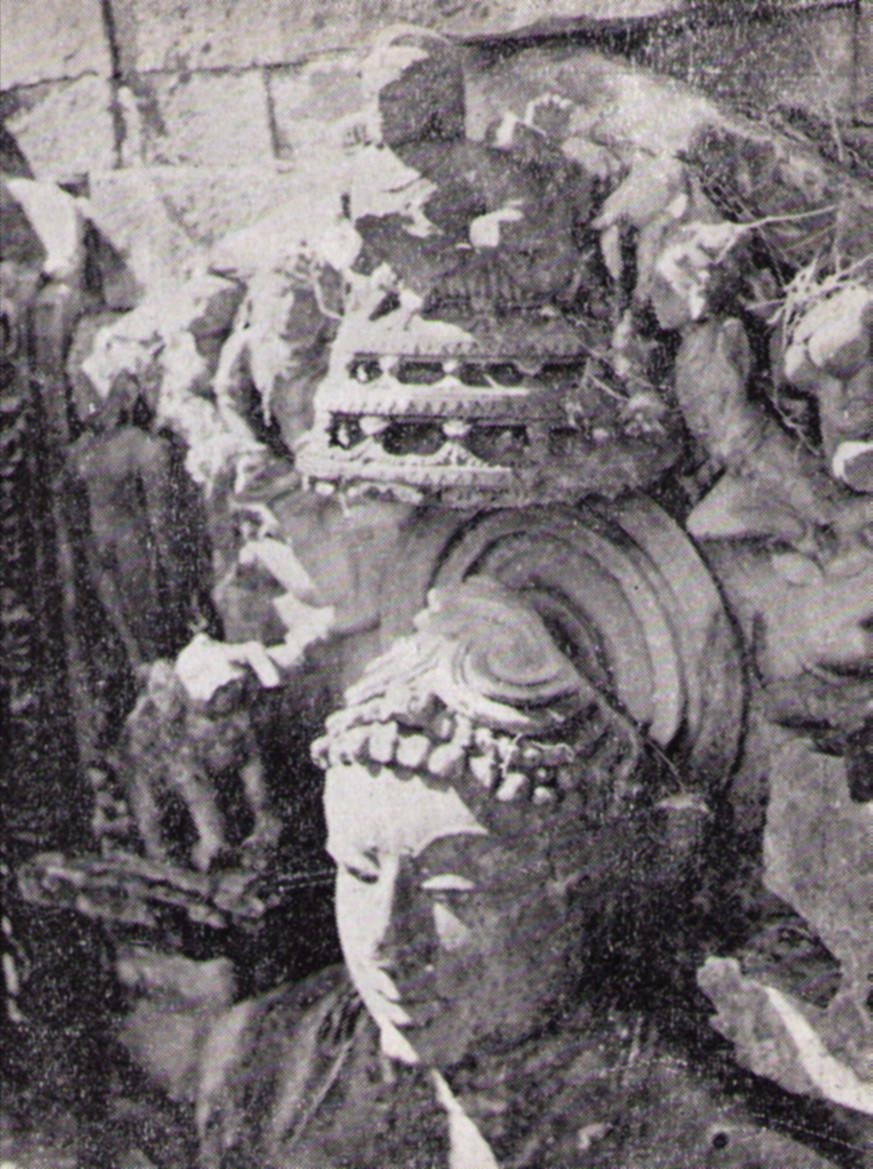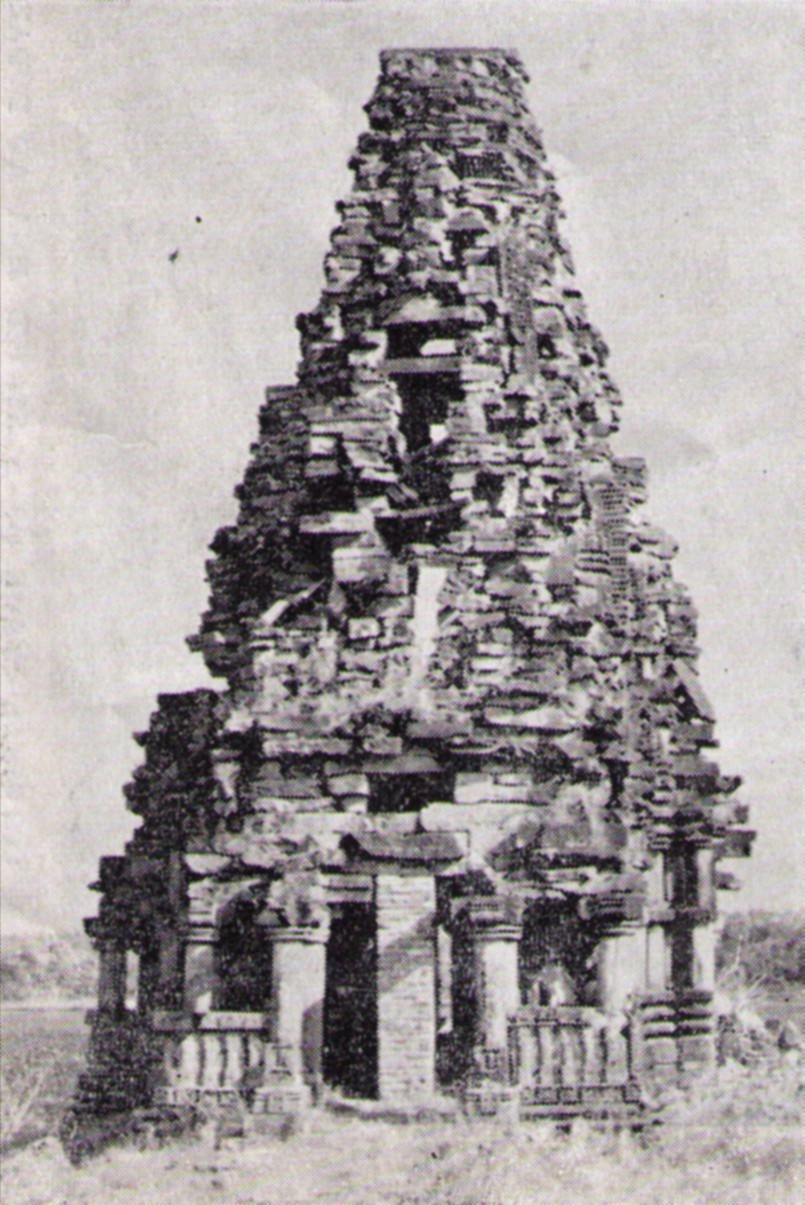
The text of this paper, published in November 1958 in Jain Yug (pp. 29-33), has been recently revised by the author. To make this online reissue citeable, the page numbers are added to the text (see squared brackets).
Jain Tirthas in Madhyadesha (I)
[29] We intend to contribute here and in the forthcoming issues of Jain Yug a series of short articles dealing with selected Jain monuments at various places in Madhya Pradesh and the surrounding area. At present, information on these sites is available only for the specialist who has access to the archaeological reports written by D.R. Bhandarkar, Sir Alexander Cunningham, A. Führer, M.B. Garde, H. Hargreaves, Sir John Malcolm, P.C. Mukherji, D.R. Sahni, and others. These reports which were published long ago are now for the most part out of print and can be consulted only in the big libraries. Moreover, lists of monuments which facilitate the orientation have not yet been published for all parts of the area. Only in the case of the former Gwalior State and the former Central Provinces the relevant monuments have been listed. [1] Under these circumstances it may not be out of place if we direct the attention of the wider public to the half-forgotten temples of Madhyadesha.
While describing a piece of Indian art, we have to distinguish between those features which are common to all specimens following a particular type, and those specific to the piece under discussion. Unless we observe this distinction, we run the risk of repeating familiar facts again and again and may miss at the same time the genuine differences. Only a piece which is unique in its style and iconography deserves a full description. In all other cases an abbreviated procedure - bringing into relief the peculiar features but curtailing the rest - is preferable. Such a discriminating treatment will no doubt detract from the harmony and balance of the picture, but there is no other way of clearing a path through the jungle of India's monumental antiquities. [2] We have inserted these introductory remarks in the hope that they might explain the austerity of style and the brevity of description.
 |
Fig. 1. Colossal image of a seated Jina at Dudahi |
1. Dudahi
Dudahi is situated about 18 miles to the south of Lalitpur in the Jhansi District of Uttar Pradesh. From Dhaura Railway Station (on the Bhopal-Jhansi Line) the Forest Rest-House Dudahi is situated 7 miles away along a forest-road. Reports on the place have been published by Cunningham, Führer, and Mukherji. [3] The present village of Dudahi is situated to the north of the [29|30] former Rām Sāgar. This was an artificial lake formed by an embankment thrown on its southern side over a rivulet called Mugha Nala. Only recently the embankment was cut and the area of the lake taken under cultivation. The old village, on account of its ramparts locally known as “Koṭ”, is now deserted. It was built on the south-west corner of the lake. Mukherji speaks of a still earlier settlement, called Būḍhī Dudahi and situated to the north and south of the “Koṭ”. Ruins of Hindu and Jain monuments, all in a more or less ruined condition and accessible only by footpaths, are scattered over the area to the west and to the south of the lake. Although the extant structures and sculptures are not of first rate importance, it would be sad if the decay of the site, which has made rapid progress since Cunningham's visit, were to continue. The Jain monuments require no special preservation measurements, but it must be. feared that the extant Hindu temples will collapse completely if no steps were taken to protect them against further ruin.
The Hindu monuments include the “Choṭī Surang” [4] (mostly collapsed); the “Baḍī Surang” [5] (Fig. 4 shows the better preserved side, the other side has collapsed); a circular temple of the type of the Caunsaṭ Yoginī temple at Bheraghat but without extant mūrtis; and a huge image of Narasiṁha cut in low relief in a vertical rock. The groundplan of the “Baḍī Surang” is probably unique in Northern India: the garbhagṛha is open to either side. The Narasiṁha relief is remarkable not for its age or for its artistic merits, but for its unusual dimensions: it measures 27 feet in height. All the monuments can be assigned to the 10th to 12th century, the Narasiṁha alone being later.
 |
Fig. 2. Colossal image of a standing Jina at Dudahi |
Amongst the Jain monuments two colossal images [6] stand out. They can easily be reached from the forest rest-house by a path running on the ridge of the embankment. They fall within the main group of monuments (on the south-west corner of the Rām Sāgar) which include also the two Surangs. The seated Jina (Figs. 1 and 3) faces eastwards, the standing Jina (Fig. 2) faces westwards. The latter monument is situated to the east of the former. Both sculptures are protected by high walls, the standing figure on all four sides, the seated one on three sides (the front being open). The walls are for the most part later repair-work, and the only part of the old structures which is still intact is a four-pillared maṇḍapa in front of the cella with the standing Jina.
The seated Jina (Figs. 1 and 3). This is actually a composition of three Jinas, one seated in the middle and two standing to the left and right. The central mūrti measures about 12 feet in height.
We start with a discussion of the pedestal of the central image. The two lions are shown dos à dos. We see the animals only from the side, and the erect neck is set off at a sharp angle from the body. This attitude is unusual and does not recur on the pedestals of the two standing images showing one of the more familiar versions of the lion-motif. Lions of the first type are however found on the pedestals of some Jina [30|31] mūrtis at Būḍhī Chanderī (northern temple in the dharmashala compound). The centre of our pedestal is occupied by the familiar dharmacakra which is flanked by two worshippers. The “carpet” hanging down from below the Jina's cushion shows a peculiar design: the kīrtimukha [7] which appears often on this “carpet” is framed by two fabulous animals (called vyāla or śārdūla); above them we notice warriors who are fighting these monsters. These vyālas and warriors are fairly similar to those which form a frieze on the inner doorframe (dated saṁ. 1051) of temple No. 12 at Deogarh. A kīrtimukha framed by two vyālis (without warriors) appears also on the “carpet” of a Jina image at Gandarwal.
 |
Fig. 3. Upper portion of the image reproduced in Fig. 1. |
The hair-dress of the Jina is also remarkable: gracefully pleated jaṭās terminate in curved ends which continue as it were in the curls covering the head immediately above the forehead. [8] Besides, a brooch is fastened in the hair right above the centre of the forehead - a feature which is probably unique in Digambara iconography.
The remaining elements of the parikara [9] are too common to require any comment. They consist in a cushion, a halo (bhāmaṇḍala), elephants and makara-heads [10] to the left and right of the head, a triple parasol crowned by an āmalaka [11], and celestial couples and elephants on either side of the parasol. The drummer above the parasol (his drum is broken) has four arms, not two as is usual. He resembles the four-armed bracket figures which appear on the capitals of pillars and which are sometimes represented as musicians. The vertical slabs to the left and right of the central slab are partly or completely gone and we cannot make out their original appearance.
The two standing Jinas are placed on socles with reliefs of Gomukha Yakṣa (to the left) and Cakreśvarī Yakṣī (to the right) respectively. Besides, we notice to the right of Gomukha a figure under a creeper (a motif which is frequently found on lower door-jambs), and to the left of Cakreśvarī a mutilated standing figure which we cannot explain. Both figures are somewhat unusual in this context. - Each of the standing Jinas is accompanied by two types of attending figures, not by a single pair as usual. The inner attendants are small in size. The outer ones are much bigger and slightly projected; due to the asymmetry of the images these are found on one side only. The bigger attendants stand on elephants which appear on the same level as the lions (normally, the elephants which carry attendant figures are arranged on a higher level than the lions). - In the case of the right image at least we can recognize three heads of makaras and similar monsters: one above the big attendant figure, one in the angle between the snake-hoods and the shoulder, and one in the angle between the snake-hoods and the celestial above them. Normally we get either a single makara-head or three different animals (two heads and a complete figure between them). - The remaining elements do not show any exceptional features.
The two standing images differ only slightly from each other (see for example the elephants at the bottom). [31|32] As in other compositions of this type, the parikara of the standing figures is rather different from the parikara of the seated figure. There can be little doubt that the various parts of the composition were designed together and not collected from different sources. The two socles with the reliefs of Gomukha and Cakreśvarī belong for iconographic reasons to the central image. The images with the standing Jinas are asymmetrical (the miniature Jinas etc. appearing only on the inner sides) and cannot have been independent slabs in this form. Nor is it necessary to assume that a part of these slabs has been subsequently cut away; in temples Nos. 19 and 29 at Deogarh we find well preserved standing images which belonged to similar compositions and show the same irregularity. Stylistically all pieces belong together. The difference between the pedestal of the central image and the pedestals of the lateral images (see above) is however noteworthy. But probably this discrepancy is explained by the different dimensions of the images and has nothing to do with style.
On account of the jaṭās, the plaits of hair which hang down on the shoulders, and the attending Yaksa and Yaksī we can identify the seated Jina as Rsabha. Since images which are executed in the same style as our image normally show the cihna (see Jain Yug, April 1958, p. 36 f.), we can assume that Ṛṣabha's bull-symbol was originally carved somewhere below the Jina (possibly on the offset in the centre of the cushion which is now obliterated). The images to the left and right show the snake-hoods and represent therefore Pārśvanātha (or Supārśvanātha). The cihnas (snake and svastika respectively) are missing as on most images of these Jinas in Madhyadesha. - Too much importance should not however be attached to these identifications. The majority of the Jina images in our area show either some type of long hair (jaṭā etc.) and the bull cihna, or they show the snake-hoods. The popularity of these additions reflects artistic fashion rather than religious trend. Otherwise we could not understand why the artists paid so little attention to the indication of the personality of the Jina. There is for example no proper distinction between Pārśvanātha and Supārśvanātha, and the long hair which should only be shown in the case of Ṛṣabha is found with other Jinas as well.
 |
Fig. 4. So-called Badi Durang on the banks of the Ramsagar at Dudahi |
The style of the images is not different from that of many others, although the elaborate parikara is unusual in the case of the central image. Figures of this size are normally not accompanied by so many subsidiary figures and paraphernalia. There is also a marked difference between the monumental style of the seated Jina himself and the baroque character of the parikara (see also the singular design of the jaṭā). - The body of the seated Jina is heavy and well-proportioned. The waist appears immediately above the forearms and is not raised as in the case of many other seated images. The elbows are not turned outwards and the upper arms hang down vertically. The face is actually broad but it gains in height on account of the jaṭā and the vertical bands of hair on the shoulders. The whole conception is determined by a rigid system of vertical and horizontal lines and compares favourably with the nerveless and emasculated creations of other artisans of that time.
The standing Jina (Fig. 2). This image measures also about 12 feet in height. The parikara comprises only the lotus [32|33] on which the figure is standing, small vegetable objects in the hands, a lotus-flower on the head, and a bhāmaṇḍala with a simple design. Besides we have to imagine attendant figures to the left and right of the Jina. That they formed a part of the composition can only be inferred from the mortices which received the tenons by which the slabs with the attendant figures were fixed in the ground slab. - The lotus below the feet forms a solid base and is not carved in low relief as in the case of other standing Jinas. Such a thick lotus seems to be restricted to colossal images. In the hands of the Jina we find instead of the common lotus-flower a short stalk terminating in a rolled up leaf. The fingers are crooked, not straight. The lower contour of the hair forms a flat arch above the forehead.
On the pedestal there appears a dharmacakra flanked by two deer (not visible in our photograph). This group does not identify a particular Jina but can be carved on the pedestal of any of the 24 Jinas. The cakra-and-deer motif is however not very common in our area. It is therefore not impossible that it had, in our case, the meaning of a cihna, identifying the Jina as Sāntinatha.
Situated on the old lake and surrounded by thick jungle, the ancient temples of Dudahi remain unforgotten to every visitor. Our essay has done little justice to the peculiar atmosphere of this lonely place. We hope therefore that one or the other of our readers will have an opportunity to visit Dudahi himself and to enjoy like us the art of its monuments and the beauty of its scenery. [33]
D.R. Patil: The Descriptive and Classified List of Archaeological Monuments in Madhya Bharat. Gwalior 1952. - H.V. Trivedi: The Bibliography of Madhya Bhārata Archaeology, Pt. I. Gwalior 1953. - H. Cousens: Central Provinces and Berar, List of Antiquarian Remains (Arch. Survey of India, XIX, New Series). Calcutta 1897.
A. Cunningham: Archaeological Survey of India, Vol. X, p. 90 ff. Calcutta 1880. - A. Führer: Memoirs of the Arch. Survey of India, New Series Vol. II, p. 121 ff. Allahabad 1891. - P.C. Mukherji: Reports on the Antiquities in the District of Lalitpur, p. 35f. Roorkee 1899.
It as hardly necessary to add that these observations apply to the study of Indian literature (Purāṇas etc.) not less than to the study of Indian art.
The word “surang” refers to the hollow interior of the śikharas of the two temples which has been exposed to view on account of the ruinous condition of the structures.
Cunningham tried to show that this was a Jain temple. His arguments are however not very convincing.
There is a third colossal Jina (standing) mentioned in literature; I was however not able to see this specimen.
The mask of the face of a fabulous monster, one of the most common decorative motifs in Indian art.
For the combination of jaṭā and curls refer to my forthcoming paper on “Distinction in Indian Iconography” (Deccan College Bulletin 1959-60).
 Prof. Dr. Klaus Bruhn
Prof. Dr. Klaus Bruhn